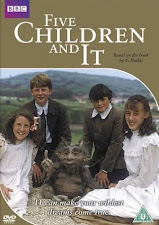The plots are often used intact without huge, unpalatable alterations as happens with Lemony Snicket's books and current Agatha Christie's works. So many times, scriptwriters for books seemed to be showing off their egos rather than telling good yarns.
With E. Nesbit, it's kind of hard to completely undermine the good yarn.
 |
| BBC Psammead voice by |
| by Francis Wright |
I determined to compare one of these adaptations of a Nesbit book to a later version: the 1991 Five Children & It to a 2004 film version, starring Kenneth Branagh, Freddie Highmore, Eddie Izzard, and Zoe Wannamaker.
 The latter borrows from The Lion, the Witch, and the Wardrobe and Dawn Treader to create an underlying plot problem, and consequently misses the essence of Nesbit's tone. C.S. Lewis was throwing children into high romance and letting them come up to snuff. Nesbit was throwing ordinary magical creatures into the lives of ordinary children and letting them manage. Both good approaches! Not quite the same tone.
The latter borrows from The Lion, the Witch, and the Wardrobe and Dawn Treader to create an underlying plot problem, and consequently misses the essence of Nesbit's tone. C.S. Lewis was throwing children into high romance and letting them come up to snuff. Nesbit was throwing ordinary magical creatures into the lives of ordinary children and letting them manage. Both good approaches! Not quite the same tone.However, the 2004 movie does capture the idea of wishes-gone-wrong. It is quite funny in parts with some of the random nonsense that appears in Nesbit's book.
 Still, when I returned to the series--which I found online--I felt the same as I did years ago: the series shows stronger adherence to the book's adventures. In addition, it not only captures the chaos of wishes-gone-wrong but the reason the children persist in obtaining wishes. Wings trap them on top of a church tower--but they got to fly! A castle under siege becomes arduous--but they enter into the spirit of resistance with absolute conviction. The joy of imagination is valued for itself.
Still, when I returned to the series--which I found online--I felt the same as I did years ago: the series shows stronger adherence to the book's adventures. In addition, it not only captures the chaos of wishes-gone-wrong but the reason the children persist in obtaining wishes. Wings trap them on top of a church tower--but they got to fly! A castle under siege becomes arduous--but they enter into the spirit of resistance with absolute conviction. The joy of imagination is valued for itself. I submit that tone and feel is often an important element of a good adaptation, an issue that will come up again when I tackle books-to-films in a later A-Z list.


No comments:
Post a Comment